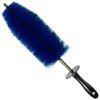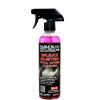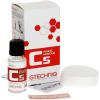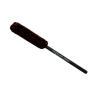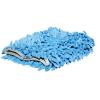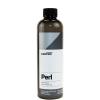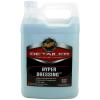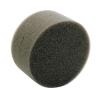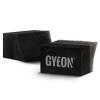Auto Detailing Guide - Wheel & Tire

Why Wheel Care Is Important (Return to Top)
Wheels can drastically change the appearance of any vehicle, which is proven by the huge after market offering. Having wheels covered in brake dust is a complete eye sore and can take away from the overall look of any vehicle. Wheels that look brand new, on the other hand, can turn heads and really show off your car. Properly caring for your wheels is not difficult or time consuming when maintained on a regular basis.
Caring for your wheels consists of properly removing contamination, polishing them to a high shine, then protecting them to make maintaining your wheels significantly easier. Stubborn brake dust can often be difficult to remove, but usually can be restored to a like new finish with the proper products and tools.
How Often Should You Care For Your Wheels? (Return to Top)
We recommend maintaining your wheels with a basic wash of soap and water with a dedicated wash mitt, every time you clean your vehicle (1 to 2 weeks). Thorough cleaning of your wheels and adding layer(s) of protection should be done every 2 to 3 months.
Wheel Care How-To (Return to Top)
When caring for your wheels it is important that you have the proper products and tools. It is also important to know what type of wheels you have so you use the proper products on them. If you have factory alloy wheels, chances are they have a layer of clear coat on your wheels. This makes things easy because you can use a variety of wheel cleaners without worrying about oxidizing your wheels finish. You can also treat them like you would your clear coat on your paint, which means you can wash, clay, polish and protect your wheels. After market or upgraded wheels that have a high polished finish or bare metal need to be treated carefully, otherwise you may oxidize the finish and potentially damage your wheels.
Your wheels should be completely cool when you start to clean them. If you have been out driving, even just a little bit, give them ample time to cool down before using any cleaner on them. You can spray them down with water to help them cool down but it may take some additional time for them to reach air temperature so you can begin cleaning. Clean the wheels in the shade whenever possible to avoid water marks or rinse them frequently while in direct sunlight.
Clean and Maintain
The best way to clean and maintain your wheels is by using some automotive shampoo and water with a dedicated wash mitt. This is safe for every type of wheel finish and also means you are not spending money on wheel cleaners. This is a very effective way to care for your wheels if you follow two things 1) maintaining your wheels on a regular basis 2) you have a coating of protection on your wheels.
Soap and water will help remove loose contaminants and clean wheels that are well maintained but often times stubborn build ups will require a wheel cleaner. The safest bet is to use a pH balanced (aka pH neutral) wheel cleaner, such as the SONAX Wheel Cleaner Full Effect. They can be used on any type of wheel finish and you can increase the cleaning power by letting the product dwell for several minutes if you are in the shade. Acidic wheel cleaners are highly effective but they can easily oxidize or tarnish polished wheels and other sensitive wheel finishes. Acidic wheel cleaners should only be used on factory wheels with a thick clear coat on them. When you are done rinse the wheels with a steady stream of water, be especially thorough near the lug nuts. If you see any remaining stains spot treat them with the same cleaner and a soft cloth or a wheel safe brush. Using a nylon brush or a brush with very stiff bristles can add swirls to the finish of the wheel, so look for brushes with very soft bristles or natural fibers. If you still have some remaining stains try a quality metal polish, which can generally be applied to most bare metals and clear coated wheels, see below (Polishing Wheels) for more information.
To effectively clean the inner barrels of your wheels, we highly recommend investing in an EZ Detail Brush. If you have protected your inner barrels with some protection (chances are you needed to do this with the wheels off of the vehicle) then you can dip the brush in soap and water and brake dust should come off very easily. If your wheels were not protected, spray some wheel cleaner on the inner parts of your wheels as well as your EZ Detail Brush to get a deeper clean. We recommend cleaning the inner barrels of your wheels first because when you pull the bristles back out, it can transfer some dirt and contamination on the face of your wheels.
Using a clay bar on your wheels is an effective way to properly prep the surface and remove stubborn brake dust. Be careful using one on high polished wheels as you could add micro-marring or swirls that can be difficult to remove.
Polish
Polishing your wheels can help increase the depth and gloss of your wheels as well as remove minor surface imperfections. If your wheels have a clear coat on them, then you can treat them the same as you would polishing your paint. If your wheels consist of bare metal, such as the lip of your wheel, you can polish them using a metal polish to increase gloss and depth and remove minor imperfections.
How-To Polish Wheels- Step 1: Dispense a pea sized drop of metal polish on a foam applicator pad
- Step 2: Using as little pressure as possible, spread the polish thinly over the area you wish to polish
- Step 3: Starting with light pressure work the polish into the wheel, increasing pressure as needed
- Step 4: Continue working the polish into the wheel until the polish turns to a clear milky haze
- Step 5: Using a clean microfiber towel, remove the broken down polish
- Step 6: Repeat steps 1 through 5 until the entire wheel has been polished
Note: Always test your polish on a small inconspicuous area before polishing your entire wheel.
Protect
When it comes to keeping your wheels looking like new for long periods of time you want to make sure your wheels are always protected. While you can use a sealant or wax to protect your wheels, there are some products that are designed specifically for your wheels. Poorboy's World Wheel Sealant is our favorite wheel protectant as it is easy to apply and remove, leaves behind a super slick surface so brake dust slides right off, is designed to withstand high temperatures that brakes produce, increases the depth and gloss of your wheels and makes cleaning your wheels a breeze.
Wheel Care Facts and Tips (Return to Top)
- Maintain your wheels with shampoo and water with a dedicated wash media
- Keeping a coating of protection on your wheels will make maintaining them significantly easier
- Always use a pH balanced wheel cleaner when dealing with after market wheels
- Acidic based wheel cleaners can easily oxidize a high polished finish
- Using a clay bar can effectively prep your wheels for polishing and protecting
- Polishing your wheels can increase the depth and gloss as well as remove some imperfections
- Protecting your wheels with a sealant is the key to easy maintenance on your wheels
Product Recommendations
Why Tire Care Is Important (Return to Top)
Caring for your tires means more than just slapping on some tire dressing and calling it a day. A lot of detailing enthusiasts do not understand the importance of properly prepping your tires before applying a dressing. Properly prepping your tires can help increase the durability of your dressing and minimize tire dressing sling.
There are various types of tire dressing on the market: water based and silicone based. Water based tire dressings get absorbed into your rubber and can actually nourish your rubber keeping them soft and flexible. Silicone based tire dressings mainly sit on the surface of your tire, which often leads to tire dressing sling. Silicone based dressings can dry out your rubber and also brown it over time. Silicone based dressings are typically glossier than water based dressings.
How Often Should You Care For Your Tires? (Return to Top)
We recommend dressing your tires after each wash (every 1 to 2 weeks). The condition of your tires will determine if they need to be cleaned and prepped. If you wash your tires and there is still dirt and contamination, we recommend using a degreaser on your tires to clean them and strip off any previous tire dressing. If you have high polished wheels, make sure the tire cleaner is safe for your wheel finish, in case you get product on them.
Tire Care How-To (Return to Top)
Cleaning your tires is pretty simple. We recommend using a dedicated wash mitt or sponge (foam media tends to work better since it's more durable) for your wheels and tires. Wash them with soap and water and assess if they need a deeper cleaning. If you are looking to get the most out of your dressing, we recommend cleaning your tires with a degreaser and a firm brush. Soak your tires with the degreaser and allow it to penetrate for a couple of minutes. Scrub your tires with the brush to remove the heavy contamination.
Applying the tire dressing is pretty straight forward. Simply dispense some tire dressing onto an applicator pad and work it into your tires. You want to use as little product as possible to prevent sling onto your paint. You are better off applying multiple thin coats of tire dressing than one thick coat. For complete even coverage, move your vehicle forward or backwards to apply dressing on the part of the tire that was closest to the ground.
Tire Care Facts and Tips (Return to Top)
- Silicone based tire dressings have a higher tendency to sling up onto your paint
- Water based tire dressings get absorbed into your tires and nourish your rubber
- Properly prepping your tires prior to applying a dressing can increase durability and prevent tire dressing sling
- Always apply your tire dressing in thin, even coats
- Drive your vehicle a few feet forward after applying the first coat of dressing so you can get an even application on the part of the tire that was closest to the ground
Product Recommendations
Related Articles (Return to Top)
Here are a few articles related to Wheel & Tire Care from our Ask-a-Pro Detailer Blog:
- How To Prep and Protect Your Tires the GYEON Way
- Product Review: P&S Brake Buster Non Acid Wheel Cleaner
- Tips to Polish and Protect Polished Aluminum
- Product Review: Sonax Wheel Cleaner Plus
- How to Detail Your Wheels, Tires, and Wheel Wells
- How to Clean Your Tires With a Purpose
- My Go-To Wheel and Tire Cleaning Products
- How to Avoid Tire Dressing Sling
- Airbrush Application: Wheel Coatings
- How to Properly Clean Wheels: Lug Nuts, Faces and Barrels...Oh My!
- Product Review: Gtechniq C5 Wheel Armour
- Auto Detailing Myth: Tire Sling is Caused By Product
View all Wheel & Tire Care articles
Related Videos (Return to Top)
Ask-a-Pro Blog author James Melfi goes through the process of properly cleaning your wheels in the first video below. In the second video, James explains how to properly dress your tires.


